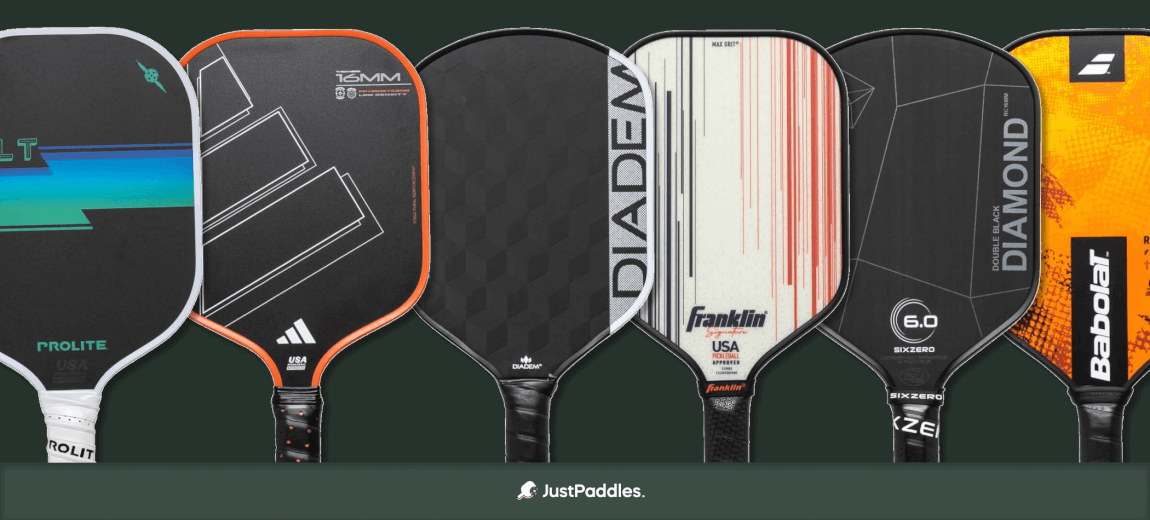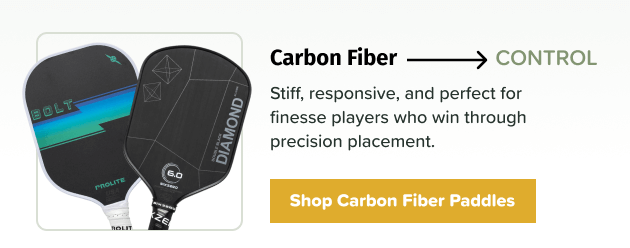Carbon Fiber vs. Composite Pickleball Paddle: Which Wins?
When you're shopping for new pickleball paddles, one of the many decisions you'll face is choosing between carbon fiber and composite face materials. These two materials dominate the market for good reason. They each bring different advantages to the court. The thing is, there's no universal "best" choice here. What works for your doubles partner might not work for you, and that's completely normal! In this article, the Paddle Experts at JustPaddles break down everything you need to know about carbon fiber pickleball paddles vs composite pickleball paddles so you can find out which one actually makes sense for how you play.
What is a Carbon Fiber Pickleball Paddle?
Material Basics
Carbon fiber paddles feature faces made from tightly woven fibers that create a stiff yet surprisingly lightweight surface. You've probably seen carbon fiber used in high-end sports gear or race cars without even realizing it. It's been used for years in applications where strength and light weight matter. The key thing to know is that carbon fiber doesn't flex much when the ball hits it, and that stiffness changes the way shots feel and respond.
Performance Characteristics
Here's where carbon fiber really matters: control. When the ball hits a carbon fiber face, you get this softer, more responsive touch that makes it way easier to place shots exactly where you want them. If you love dinking at the kitchen line, dropping the ball just over the net, or threading shots into tight corners, carbon fiber gives you the precision to pull it off consistently. The material also does an excellent job absorbing vibration, which means less shock traveling up your arm. A big plus if you're dealing with any elbow or shoulder issues, or if you just want your paddle to last longer!
Another benefit that experienced players really appreciate is the spin potential. Carbon fiber surfaces tend to have more texture, which helps you put serious rotation on the ball when you need it. The trade-off? You're not going to get as much natural pop compared to composite, so generating power is more about your technique and swing speed.
Player Profile
Carbon fiber tends to attract intermediate to advanced players who've developed solid mechanics and don't need help generating power. If you're someone who'd rather win points through smart placement than trying to overpower everyone, carbon fiber is probably worth looking into. These paddles reward players who have good hand-eye coordination. If you can consistently hit the sweet spot and control your swing, carbon fiber will amplify those skills.
What is a Composite Pickleball Paddle?
Material Basics
Composite paddles use faces made from woven glass fibers, which creates a surface that's noticeably more flexible and springy than carbon fiber. This material has been around in the pickleball world for quite a while and remains popular across all skill levels. Where carbon fiber is stiff and controlled, composite has some give to it. That flexibility creates what players often call a "trampoline effect", meaning the face flexes slightly when the ball hits it and then springs back, adding extra energy to your shot.
Performance Characteristics
The big selling point of composite is power. That springy surface naturally generates more pop, which means you can hit harder shots without having to swing out of your shoes. composite paddles also tend to have larger sweet spots, giving you more forgiveness when you don't make perfect contact. This is especially helpful when you're still working on consistency or when you're stretched out trying to reach a ball.
The flip side is that composite doesn't offer quite the same level of finesse and touch that carbon fiber does. You'll still be able to dink and drop, but you might find it a bit harder to execute those really soft, delicate shots. The surface provides decent spin potential, though generally not as much texture as you'd get with carbon fiber. For a lot of players, especially those who prefer an attacking style, the extra power is worth the trade-off in touch.

Player Profile
composite is great for beginners who are still developing their swing and need some help generating pace on the ball. But it's not just for newbies! Plenty of experienced players who favor an aggressive, power-based game stick with composite because it supports their style so well. If you find yourself playing from the baseline more than the kitchen, or if you're the type who likes to put the ball away rather than extend rallies, composite gives you that extra punch you're after. These paddles can be slightly heavier depending on how they're constructed, but many players actually like the added mass for driving through the ball.
Carbon Fiber vs composite: Side-by-Side Comparison
|
Feature |
Carbon Fiber |
composite |
|
Control/Touch |
High: soft feel and precise responsiveness |
Moderate: more spring than touch |
|
Power |
Moderate: power comes from your swing |
High: naturally powerful surface |
|
Spin Potential |
Excellent due to textured surface |
Good but typically less textured |
|
Durability |
High: very strong, long-lasting material |
Moderate: more prone to wear over time |
|
Weight Range |
Typically lighter |
May be slightly heavier |
|
Price Point |
More expensive |
More affordable |
|
Best For |
Control-focused, finesse players |
Power players, newer players |
Which Material Is Better for You?
By Skill Level
If you're just getting started with pickleball, composite is probably the easier entry point. The extra power helps compensate while you're still figuring out your mechanics, and that larger sweet spot means you don't have to be quite as precise with your contact point. As you improve and your technique develops, you might find yourself drawn to carbon fiber for the added control it provides. A lot of advanced players prefer carbon fiber because they can generate their own power and really value the precision that comes with a stiffer, more responsive face.
The Experts at JustPaddles break down what paddles is for a player first starting out!
By Play Style
Your natural playing style matters more than your skill level here. If you're someone who loves hanging out at the kitchen line, enjoys a good dinking rally, and wins most of your points through patience and smart placement, carbon fiber is probably your match. The soft touch and excellent control make it ideal for finesse-based play where you're trying to outthink your opponent rather than overpower them.
On the other hand, if you're aggressive by nature, like hitting hard drives, and prefer to finish points quickly with power shots, composite is going to support that style better. The extra pop helps you keep opponents on their heels without requiring picture-perfect mechanics on every swing. Some players just like hitting the ball hard, and there's nothing wrong with that approach if it wins you games.
By Budget
Let's talk about the elephant in the room…price. Composite paddles are generally more wallet-friendly, which makes them attractive for players who want solid performance without spending a fortune. Carbon fiber paddles usually cost more due to the material itself and the manufacturing process involved, but a lot of players find the investment worth it for the enhanced control and durability. If you're not sure which material you'll prefer yet, starting with a quality composite paddle is a smart way to get on the court without overcommitting financially.
Hybrid Faces
Some manufacturers are now making hybrid paddles that combine both materials. These might use carbon fiber in certain zones and composite in others, or layer the materials in ways that try to capture the best of both worlds. Hybrid faces aim to give you the control of carbon fiber and the power of composite in one package. If you're genuinely torn between the two materials and can't decide which characteristics matter more to you, a hybrid paddle might be worth exploring as a middle ground.
Find the Perfect Paddle for Your Game
Choosing between carbon fiber and composite is just one piece of the puzzle when it comes to finding your ideal paddle. Core thickness, paddle shape, weight, and grip size are all factors that influence how a paddle feels and performs. That's exactly why we created the Paddle Coach.
The Paddle Coach asks you a few simple questions about your skill level, how you like to play, and what matters most to you in a paddle. Then it gives you personalized recommendations that actually make sense for your game. No more drowning in hundreds of options or second-guessing whether you're looking at the right paddles. Just targeted suggestions based on what you told us about how you play.
Finding the Right Paddle Starts with Knowing Your Game
At the end of the day, the carbon fiber vs composite question really comes down to understanding what you need from your equipment. Neither material is objectively "better", they're just built for different approaches to the game.
Take an honest look at how you actually play, not how you think you should play or how your favorite pro plays. Are you someone who wins points through patience and placement? Carbon fiber makes a lot of sense. Do you prefer to attack and put balls away? composite is probably your friend.
The Paddle Experts at JustPaddles are always here to help you sort through these decisions. Whether you've got questions about specific paddles, need advice on matching a material to your style, or just want to talk through your options, we're here for it.
Questions about carbon fiber vs composite paddles? Our Paddle Experts are standing by at 866-382-3465, experts@justpaddles.com, or via live chat. We're JustPaddles, and we're with you from Click to Court!




-24a9-10-25.png)







